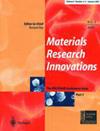基于绿色合成的氧化铁纳米材料修饰的碳糊电极对刚果红的电化学分析和电容性能
Q2 Engineering
引用次数: 1
摘要
在本研究中,采用一种简单的方法将无价值的橙子皮(OP)废物转化为一种新的氧化铁橙子皮纳米材料(FeOP)。通过傅里叶变换红外光谱、x射线衍射、热重和扫描电子显微镜-能量色散x射线等物理化学表征证实了改性OP中氧化铁纳米颗粒的存在。用FeOP修饰的碳糊电极(CPE/FeOP)在NaCl溶液中,在10 m.s−1条件下,比CPE的比电容提高了2倍,达到2939 F.g−1。用CPE/FeOP对刚果红(CR)水溶液进行电分析,在去离子水和泉水中检测限分别为2.8 × 10−7 mol.L−1和8.2 × 10−7 mol.L−1,线性范围为5 ~ 55µM。因此,CPE/FeOP电化学传感器适用于废水中刚果红的测定。本文章由计算机程序翻译,如有差异,请以英文原文为准。
Electrochemical sensor based on green-synthesized iron oxide nanomaterial modified carbon paste electrode for Congo red electroanalysis and capacitance performance
ABSTRACT In this study, a facile protocol was used to convert non-valuable orange peels (OP) waste into a new sensing iron oxide orange-peel nanomaterial (FeOP). The presence of iron oxide nanoparticles in the modified OP was confirmed by physicochemical characterisations including Fourier-transform infrared spectroscopy, X-ray diffractometry, thermogravimetry, and scanning electron microscopy-energy dispersive X-ray. FeOP was used to modify a carbon paste electrode (CPE/FeOP) which displayed a significant increase in specific capacitance of 2939 F.g−1, two folds higher than that obtained with CPE at 10 m.s−1 in NaCl. The electroanalysis of Congo red (CR) in aqueous solutions using CPE/FeOP displayed detection limits of 2.8 × 10−7 mol.L−1 and 8.2 × 10−7 mol.L−1 respectively in deionised and spring waters, in the linear range of 5 to 55 µM. CPE/FeOP electrochemical sensor is therefore suitable for the determination of Congo red in wastewater.
求助全文
通过发布文献求助,成功后即可免费获取论文全文。
去求助
来源期刊

Materials Research Innovations
工程技术-材料科学:综合
CiteScore
5.20
自引率
0.00%
发文量
38
审稿时长
2.8 months
期刊介绍:
Materials Research Innovations covers all areas of materials research with a particular interest in synthesis, processing, and properties from the nanoscale to the microscale to the bulk. Coverage includes all classes of material – ceramics, metals, and polymers; semiconductors and other functional materials; organic and inorganic materials – alone or in combination as composites. Innovation in composition and processing to impart special properties to bulk materials and coatings, and for innovative applications in technology, represents a strong focus. The journal attempts to balance enduring themes of science and engineering with the innovation provided by such areas of research activity.
 求助内容:
求助内容: 应助结果提醒方式:
应助结果提醒方式:


